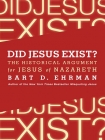Did Jesus Exist? - The Historical Argument for Jesus of Nazareth Bart Ehrman (books to read in your 20s txt) 📖

- Author: Bart Ehrman
Book online «Did Jesus Exist? - The Historical Argument for Jesus of Nazareth Bart Ehrman (books to read in your 20s txt) 📖». Author Bart Ehrman
In his apocalyptic views, then, Jesus was probably more like the Essenes than the other Jewish groups. But he was not an Essene, and he held many different views as well. His views were molded, in particular, by his association with John the Baptist, an apocalyptic preacher who anticipated the imminent end of the age. Before discussing that association, we need to learn more generally about Jewish apocalypticism, for it was adhered to and proclaimed by a wide range of Jews in the days of Jesus.
Jewish Apocalypticism
THE WORLDVIEW THAT SCHOLARS call apocalypticism developed in Jewish history before the time of Jesus, and I have discussed the historical details elsewhere.7 Suffice it to say here that about a century and a half before Jesus was born, a number of Jews became radically distraught with the course of political and military affairs. The nation of Judea had been controlled by foreign powers for centuries—first the Babylonians in the sixth century BCE, then the Persians, then the Greeks, and then the Syrians. In resistance to Syrian atrocities, in 167 BCE an indigenous uprising occurred headed by a Jewish family known as the Maccabees. This Maccabean Revolt eventually led to an independent state of Judea, which lasted for nearly a century until the Romans conquered the land in 63 BCE.
Along with political woes before the revolt came a kind of theological crisis. For centuries certain Jewish prophets had declared that the nation was suffering because God was punishing it for turning away from him (thus prophets such as Hosea, Amos, Isaiah, Jeremiah, and—well, just about all the prophets of the Hebrew Bible). But in this period, under the Syrians, many Jews had turned back to God and were doing precisely what he instructed them to do in the Torah. And yet they were suffering worse than ever. How could that be?
Jewish apocalyptic thinking arose in the context. It came to be thought that the suffering of the people of God was not a punishment for sin inflicted by God himself. On the contrary, it was punishment for righteousness, inflicted by forces of evil in the world, which were aligned against God. The first clear literary expression of such a view is found in the book of Daniel, the last book of the Hebrew Bible to be written (around 165 BCE?). The view eventually became widely popular among Jews, as their woes continued. In the days of Jesus it was a view held by Pharisees, Essenes, and prophetic groups such as the one headed by John the Baptist.
The view is called “apocalyptic” from the Greek word apocalypsis, which means a “revealing” or an “unveiling.” Jewish apocalypticists believed that God had revealed to them the heavenly secrets that made sense of mundane realities. The short version is that God, for mysterious reasons, had temporarily ceded control of this world over to powerful cosmic forces that are opposed to him, his purposes, and his people. That was why the people of God experienced such pain and misery. But God would soon reassert his sovereignty over this world and destroy the forces of evil to vindicate his people, restore them to a place of privilege, and bring in a good, utopian kingdom that would last forever.
This point of view can be found in a number of Jewish writings from the period, including, for example, the Dead Sea Scrolls and Jewish apocalypses that did not become part of the Bible. An examination of these works shows that most Jewish apocalypticists subscribed to four major tenets of thought.
Dualism
Most basically, apocalypticists were dualists. They believed there were two fundamental components of reality, the forces of good and the forces of evil. The ultimate source for all that was good, of course, was God. But God had a personal enemy, called by various names: the Devil, Satan, Beelzeboul. (Before the development of apocalyptic thought, Jews did not subscribe to the idea of a personal Devil as God’s archenemy. He is not found in Jewish scripture. Apocalypticists, by contrast, very much believed he existed.) Moreover, just as God had angels who did his will, the Devil had demons who did his. And there were other cosmic forces in the world—principalities, authorities, and powers. God had the power to give life while the forces of evil had the power of death, not to mention all the pain, misery, and suffering en route to it.
The struggle between the forces of good and evil had radical and dire consequences for humans. A cosmic battle was going on, and the powers of evil were in the ascendancy. That is why this world was such an awful place, with all its famines, droughts, epidemics, earthquakes, poverty, injustice, and war.
This cosmic dualism worked itself out in a historical scenario, also dualistic, involving this age and the age to come. The present age was controlled by the powers of evil: the Devil and his minions. But there would be a future age in which all that is opposed to God would be destroyed and a good kingdom would appear. Then God, along with all that is good, would reign supreme. There would be no more famine, drought, natural disaster, war, or hatred. Those who entered into this new age would be rewarded with eternal peace, joy, and bliss. They would be able to love and serve God without fear, and they would live in harmony in a world of rich abundance forever.
Pessimism
Even though for apocalypticists the long-term picture looked very good, the short-term looked very bleak. Apocalypticists were thoroughly pessimistic about the prospects of life in the present age.





Comments (0)